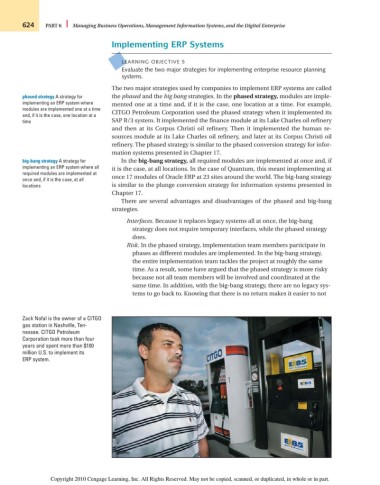Page 650 - Introduction to Business
P. 650
624 PART 6 Managing Business Operations, Management Information Systems, and the Digital Enterprise
Implementing ERP Systems
LEARNING OBJECTIVE 5
Evaluate the two major strategies for implementing enterprise resource planning
systems.
The two major strategies used by companies to implement ERP systems are called
phased strategy A strategy for the phased and the big bang strategies. In the phased strategy, modules are imple-
implementing an ERP system where mented one at a time and, if it is the case, one location at a time. For example,
modules are implemented one at a time
and, if it is the case, one location at a CITGO Petroleum Corporation used the phased strategy when it implemented its
time SAP R/3 system. It implemented the finance module at its Lake Charles oil refinery
and then at its Corpus Christi oil refinery. Then it implemented the human re-
sources module at its Lake Charles oil refinery, and later at its Corpus Christi oil
refinery. The phased strategy is similar to the phased conversion strategy for infor-
mation systems presented in Chapter 17.
big-bang strategy A strategy for In the big-bang strategy, all required modules are implemented at once and, if
implementing an ERP system where all it is the case, at all locations. In the case of Quantum, this meant implementing at
required modules are implemented at
once and, if it is the case, at all once 17 modules of Oracle ERP at 23 sites around the world. The big-bang strategy
locations is similar to the plunge conversion strategy for information systems presented in
Chapter 17.
There are several advantages and disadvantages of the phased and big-bang
strategies.
Interfaces. Because it replaces legacy systems all at once, the big-bang
strategy does not require temporary interfaces, while the phased strategy
does.
Risk. In the phased strategy, implementation team members participate in
phases as different modules are implemented. In the big-bang strategy,
the entire implementation team tackles the project at roughly the same
time. As a result, some have argued that the phased strategy is more risky
because not all team members will be involved and coordinated at the
same time. In addition, with the big-bang strategy, there are no legacy sys-
tems to go back to. Knowing that there is no return makes it easier to not
Zack Nofal is the owner of a CITGO
gas station in Nashville, Ten-
nessee. CITGO Petroleum
Corporation took more than four
years and spent more than $100
million U.S. to implement its
ERP system.
Copyright 2010 Cengage Learning, Inc. All Rights Reserved. May not be copied, scanned, or duplicated, in whole or in part.

